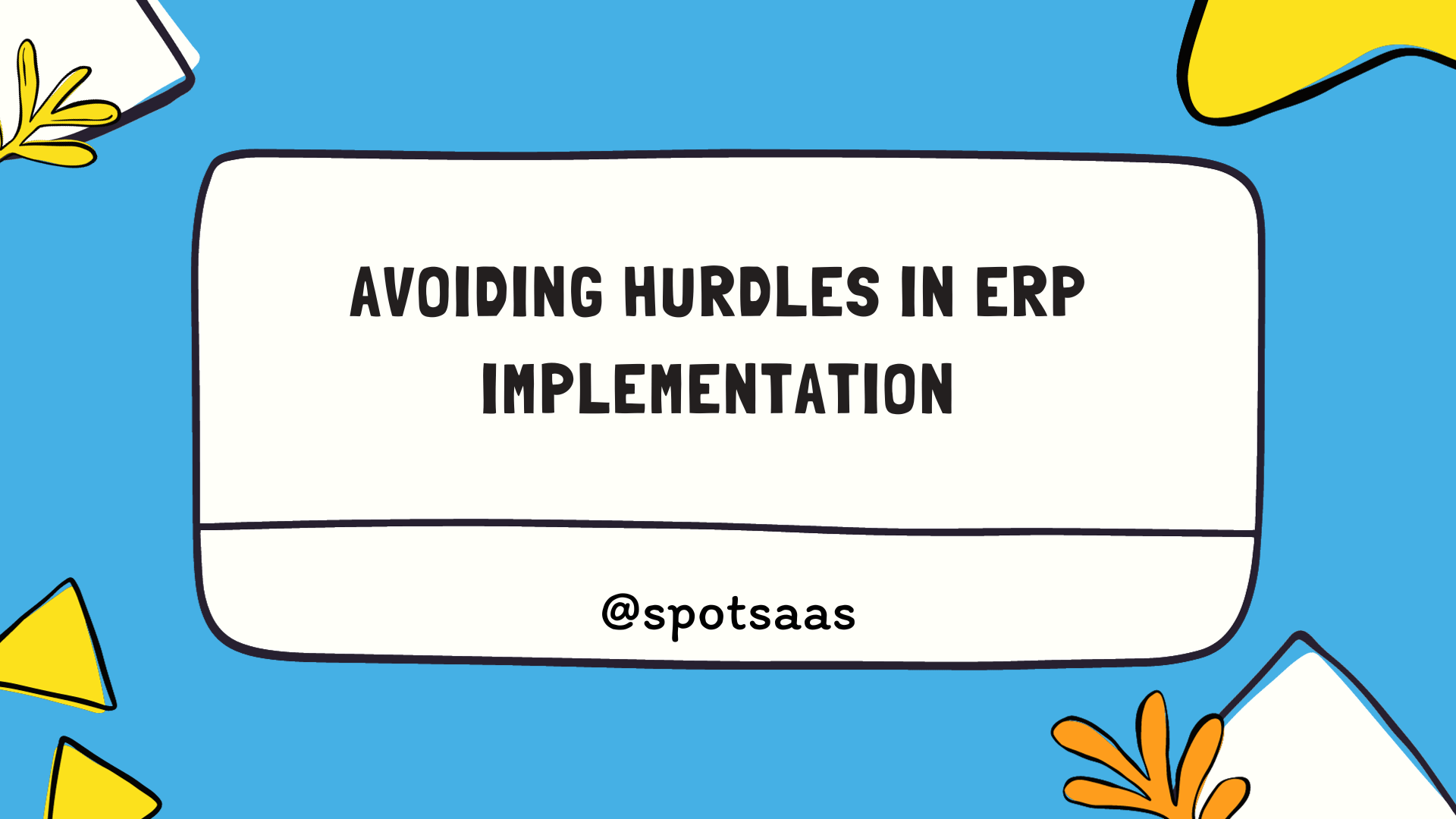Are you in the midst of implementing an ERP system and feeling like it’s more akin to climbing a mountain than conducting a software adjustment? Rest assured, this uphill struggle is not yours alone.
It’s a path I’ve traversed too, and along that trail, I discovered something surprising – 75% of ERP projects don’t actually reach the summit due to common implementation obstacles.
Key Takeaways
- Gathering accurate and detailed requirements from all stakeholders before choosing an ERP system is crucial to avoid poor software fit and inaccurate requirements.
- Insufficient team resources can be overcome by seeking assistance from professionals experienced in implementing an ERP system or investing more in training existing staff members.
- Lack of accountability in decision-making can be avoided by establishing clear roles and responsibilities for decision-making throughout the implementation process.
- Investing in comprehensive change management strategies, including effective communication, training programs, and ongoing support for employees, helps overcome the challenge of a lack of investment in change management.
Understanding ERP and ERP Implementation
Enterprise Resource Planning, also known as ERP, serves as a shared database for various business processes. With this system in place, departments within a company can streamline data and collaborate more effectively.
An ERP software can centralize customer relationship management, accounting, procurement and supply chain operations under one unified platform.
The process of putting this system into action is referred to as ERP implementation. This endeavour requires careful planning and execution to ensure success. One major component involves choosing the right software that aligns with the specific needs of your organization.
Another crucial aspect entails handling people-related issues to inhibit operational setbacks or business disruption during the transition period. Inadequate preparation or lack of executive support often leads to complications down the line; hence it’s essential these areas are thoroughly addressed from start to finish in an ERP implementation strategy.
Common Challenges in ERP Implementation
The common challenges in ERP implementation include poor software fit/inaccurate requirements, insufficient team resources, lack of accountability in decision-making, lack of investment in change management, insufficient training/support, and insufficient data cleansing.
Poor software fit/inaccurate requirements
There’s a tricky pothole on the road to ERP implementation: poor software fit and inaccurate requirements. This issue often arises when there’s a mismatch between business needs and the selected system.
It’s crucial that we recognize this early on as this hurdle can significantly hinder our operations, causing unnecessary disruptions.
To avoid this common mistake in ERP implementation, it is key to gather accurate, detailed requirements from all relevant stakeholders before choosing an ERP system. Misunderstandings or oversights at this stage result in selecting software that doesn’t align with the unique workflow of your organization.
Nothing adds more complexities than realizing mid-way through your project journey that the chosen ERP platform falls short of meeting major functional aspects needed for smooth functioning.
So, getting these initial steps right bypasses future pitfalls and sets up your project for ultimate success.
Insufficient team resources
One of the significant hurdles in ERP implementation is insufficient team resources. This issue arises when there’s a shortage of employees with the necessary skills to execute tasks effectively.
In many cases, an organization may underestimate the manpower needed for different aspects of ERP implementation, from project management to technical support. If your company does not have enough adequately trained staff members available, it creates a gap that extends timelines and can ultimately lead to business disruption.
One way businesses can overcome this challenge is by seeking assistance from professionals experienced in implementing an ERP system or investing more into training their own staff before starting the project.

Lack of accountability in decision-making
ERP implementation requires effective decision-making at various stages of the process. One common challenge is the lack of accountability in decision-making, which can lead to delays, miscommunication, and ineffective solutions.
When there is a lack of accountability, decisions may be made without considering their impact on other departments or without clear ownership. This can result in confusion, resistance to change, and even project failure.
To overcome this hurdle, it’s crucial to establish clear roles and responsibilities for decision-making throughout the implementation process. By holding individuals accountable for their decisions and ensuring that they align with the overall goals of the project, organizations can minimize risks and ensure a smoother implementation experience.
Lack of investment in change management
One of the common challenges in ERP implementation is a lack of investment in change management. This refers to the insufficient allocation of resources, support, and training for employees who will be affected by the system changes.
Without proper change management, employees may resist or struggle to adapt to the new ERP system, leading to delays, errors, and decreased productivity. To overcome this hurdle, it is crucial for organizations to invest in comprehensive change management strategies that include effective communication, training programs, and ongoing support for employees throughout the implementation process.
By prioritizing change management efforts and providing adequate resources and support, businesses can minimize resistance and ensure a smoother transition to the new ERP system.

Insufficient training/support
Insufficient training and support can pose significant challenges during ERP implementation. Without proper training, employees may struggle to understand the new system, leading to decreased productivity and errors.
It is crucial for companies to invest in comprehensive training programs that cover all aspects of the ERP system, including its features, functionalities, and best practices for usage.
Additionally, ongoing support is essential to address any issues or questions that may arise after the initial implementation. Without adequate support mechanisms in place, employees may feel unsupported and frustrated when encountering difficulties with the new system.
Providing access to a help desk or knowledgeable resources can ensure timely assistance and prevent disruptions in business operations.
By prioritizing sufficient training and ongoing support throughout the implementation process, companies can empower their employees with the necessary skills and knowledge to effectively utilize the ERP system.
Insufficient data cleansing
Insufficient data cleansing is a common challenge that can hinder the successful implementation of an ERP system. When data is not properly cleansed before migration, it can lead to inaccurate and incomplete information in the new system.
This can result in errors, delays, and inefficiencies in business operations. To overcome this hurdle, it is crucial to dedicate sufficient time and resources to clean and validate data before migrating it to the new ERP system.
By ensuring that data is accurate, consistent, and up-to-date, businesses can avoid potential disruptions and make better-informed decisions based on reliable information. Proper data cleansing is a key factor in unlocking the full potential of operations with a new ERP system.

How to Avoid ERP Implementation Failures
To avoid ERP implementation failures, it is crucial to define and plan clear goals, secure commitment from business leadership, identify the ideal implementation partner, set milestones and timelines, properly address data migration, address fear of change, and plan for maintenance and training.
Read on to learn more about these important strategies for a successful ERP implementation.
Defining and planning clear goals
Defining and planning clear goals is crucial for a successful ERP implementation. Here are key steps to follow:
| Step | Action |
|---|---|
| Identify the Objectives | Define explicit objectives for implementing the ERP system, such as enhancing operational efficiency or improving data management. |
| Involve Key Stakeholders | Include department heads, managers, and end-users in the goal-setting process to ensure a comprehensive understanding of needs and expectations. |
| Make Goals Specific and Measurable | Establish clear, quantifiable targets, like reducing processing time or elevating customer satisfaction ratings, that can be tracked and assessed. |
| Prioritize Goals | Determine and organize goals based on their significance to the business to direct efforts and allocate resources effectively. |
| Align Goals with Business Strategy | Ensure the defined goals are coherent with the overarching business strategy to maintain relevance and support for the organizational vision. |
| Communicate Goals | Transparently convey the established goals to all stakeholders to promote understanding, commitment, and collaboration throughout the implementation. |
Ensuring commitment from business leadership
To ensure a successful ERP implementation, it is crucial to have strong commitment from business leadership. When leaders are fully committed to the project, they can effectively communicate its importance and rally support from the rest of the organization.
Additionally, their involvement helps drive decision-making and prioritize resources for a smooth implementation process.
Business leaders play a vital role in setting clear goals and objectives for ERP implementation. By articulating how the new system aligns with strategic initiatives, they can inspire involvement from employees at all levels.
This commitment also involves actively participating in planning sessions and making informed decisions that address potential challenges or roadblocks along the way.
Having visible support from business leadership sends a powerful message throughout the organization that this project is important and worth investing time and effort into. Their dedication encourages employee buy-in, fosters accountability, and ultimately contributes to overall project success.
Identifying the ideal implementation partner
Choosing the right implementation partner is crucial for a successful ERP implementation. It’s essential to find a partner that understands your business needs and has experience in implementing similar systems.
Look for a partner who can provide references from satisfied clients, demonstrating their track record of success. Additionally, consider their level of technical expertise and their ability to provide ongoing support throughout the implementation process and beyond.
By partnering with the right experts, you can ensure that your ERP implementation is smooth and efficient, minimizing risks and maximizing the potential benefits for your organization.
Setting milestones and timelines
To ensure a successful ERP implementation, it is important to set clear milestones and timelines. Here are some key steps to consider:
| Step | Action |
|---|---|
| Define Goals and Objectives | Establish specific, achievable goals and objectives for each phase of the ERP implementation process. |
| Break Down Tasks | Divide the project into smaller tasks and set practical deadlines for each, ensuring they are manageable and achievable. |
| Create a Project Plan | Develop a comprehensive project plan detailing the chronological order of tasks along with their respective timelines. |
| Review and Update the Plan | Continuously revisit and modify the project plan to adapt to any changes or unexpected challenges encountered during the implementation. |
| Communicate with Stakeholders | Ensure clear communication of project milestones, timelines, and any changes to all stakeholders to keep them informed and engaged. |
| Monitor Progress | Consistently track the progression of tasks and ensure alignment with predefined timelines, making adjustments as needed. |
| Address Delays Promptly | Quickly identify and address any delays or obstacles in the implementation process to maintain adherence to the project timeline. |
Properly addressing data migration
Data migration is a crucial aspect of ERP implementation. Here are some key steps to ensure it is properly addressed:
| Step | Action |
|---|---|
| Assess Existing Data | Evaluate the current data for accuracy, completeness, and consistency. Resolve any identified discrepancies or duplications. |
| Plan for Mapping and Transformation | Develop a plan detailing how data will be mapped and transformed during migration from the old to the new ERP system. |
| Set Up Test Environments | Create testing environments to validate the migration process, ensuring data is migrated accurately and identifying potential issues. |
| Prioritize Data Elements | Determine and prioritize the data elements to be migrated first, minimizing disruption and aligning with business needs. |
| Establish Backup Procedures | Initiate backup protocols before and during migration to protect data from potential loss or corruption. |
| Communicate with Stakeholders | Keep stakeholders abreast of the migration status, and inform them of any challenges or risks encountered during the process. |
| Perform Validation Checks | Conduct thorough checks post-migration to validate data accuracy and integrity, addressing any identified issues promptly. |
| Train Employees | Offer training sessions to employees on utilizing the new ERP system, ensuring they can effectively manage and access migrated data. |
Addressing fear of change
Implementing a new ERP system can be a daunting prospect for employees who are resistant to change. Addressing their fear of change is essential to ensure a smooth transition. One effective strategy is to communicate the benefits of the new system and how it will improve daily workflows and productivity.
Providing training programs and support during the implementation process can also help alleviate fears by empowering employees with the skills needed to use the new system confidently.
Additionally, involving employees in decision-making processes and seeking their input on how best to implement the changes can increase buy-in and reduce resistance. By addressing the fear of change head-on, organizations can create an environment that embraces innovation and sets themselves up for successful ERP implementation.
Planning for maintenance and training
Implementing an ERP system requires careful planning for maintenance and training to ensure its long-term success. Here are key considerations for this stage:
| Component | Action Steps |
|---|---|
| Maintenance Plan | Establish routine system maintenance schedule. Assign roles for carrying out maintenance tasks. Implement updates, patches, and security checks. |
| Training Strategy | Establish a routine system maintenance schedule. Assign roles for carrying out maintenance tasks. Implement updates, patches, and security checks. |
| User Support | Allocate resources for user support during and post-implementation. Set up a help desk or support team. Provide user manuals, knowledge bases, and forums. |
| Monitoring User Adoption | Track user engagement via metrics like login frequency. Communicate regularly with users for feedback. Address areas requiring more training or support. |
| Continual Improvement | Implement a structured feedback collection process. Evaluate system performance and identify improvement areas. Explore additional modules or features as per feedback. |
Importance of Learning from Mistakes
Learning from mistakes is crucial in ERP implementation as it allows businesses to understand the reasons behind failures, identify pitfalls, and develop strategies to overcome hurdles.
By examining inadequate planning, lack of executive support, poor data quality, and ineffective testing processes, organizations can gain valuable insights for future implementations and ensure a smoother transition to their new ERP system.

Inadequate planning and preparation
Inadequate planning and preparation can lead to significant hurdles during ERP implementation. Without a well-defined plan and proper preparation, the project may face delays, cost overruns, and even failure.
It is crucial to invest time in defining clear goals, establishing realistic timelines, and identifying potential risks early on. Adequate resources should be allocated for training and support, data cleansing, and migration processes.
By taking these steps seriously, businesses can avoid common pitfalls associated with inadequate planning and ensure a smoother ERP implementation journey.
Lack of executive sponsorship and support
When it comes to implementing an ERP system, lack of executive sponsorship and support can contribute to significant challenges and potential failure. Without the active involvement and commitment of upper management, the implementation process may lack the necessary resources, accountability, and direction.
This can lead to delays in decision-making, inadequate allocation of funds and personnel, and limited buy-in from employees. In order to overcome this hurdle, it is crucial for business leaders to understand the importance of their role in driving successful implementation.
By providing clear goals, allocating sufficient resources, fostering a culture of accountability, and actively participating throughout the process, executives can ensure that their organization has the necessary support for a smooth ERP implementation journey.
Poor data quality and migration
Ensuring data quality and a smooth migration process is crucial for successful ERP implementation. Poor data quality can lead to inaccurate reporting, decision-making, and inefficient operations.
It is essential to conduct thorough data cleansing activities before the migration phase to eliminate duplicates, errors, and inconsistencies. Additionally, a comprehensive testing plan should be in place to verify the accuracy of migrated data and identify any issues that may arise during the transition.
By addressing these challenges proactively, businesses can mitigate risks and optimize their ERP system’s performance from day one.
Ineffective testing and quality assurance
During ERP implementation, ineffective testing and quality assurance can create significant challenges. Insufficient testing can lead to the discovery of software defects or functionality gaps only after the system is live, resulting in disruptions to business operations.
It is crucial to ensure comprehensive and rigorous testing throughout the implementation process to identify any issues and address them before they impact daily operations. Quality assurance plays a vital role in ensuring that all aspects of the ERP system meet the desired standards and requirements.
By conducting thorough testing and implementing effective quality assurance measures, companies can minimize risks, improve system performance, and maximize the benefits of their ERP implementation efforts.
Bringing it all Together
To ensure a successful ERP implementation, it is crucial to incorporate stakeholders in the testing process and utilize test management software for effective tracking and analysis.
Additionally, choosing the right implementation partner can make all the difference in navigating potential hurdles and achieving desired outcomes.

Incorporating stakeholders in ERP testing
Incorporating stakeholders in ERP testing is crucial for a successful implementation. It ensures that the system meets their needs and promotes user adoption.
| Strategy | Key Actions |
|---|---|
| Engage Stakeholders Early On | Include stakeholders in planning and design phases. Gather insights and feedback for tailoring the system. |
| Conduct User Acceptance Testing | Involve stakeholders in UAT sessions. Collect feedback on system functionality. |
| Provide Training and Support | Offer training programs and materials. Provide ongoing support during and post-implementation. |
| Establish a Communication Channel | Maintain open communication throughout testing. Offer regular updates, reports, and feedback forums. |
| Incorporate Stakeholder Feedback | Involve stakeholders in system configuration decisions. Customize workflows based on stakeholder requirements. |
| Monitor User Experience | Utilize surveys or interviews to gauge satisfaction. Identify and address areas for improvement. |
Utilizing test management software
I found that utilizing test management software is crucial during ERP implementation. This type of software helps streamline the testing process and ensures that all aspects of the system are thoroughly tested before going live.
With test management software, you can easily create test cases, track defects, and monitor testing progress in one centralized platform. It also allows for effective collaboration among team members and provides real-time visibility into testing status.
By using test management software, companies can significantly reduce the risk of errors and ensure a smooth transition to their new ERP system without causing any disruption to business operations.
Final thoughts and choosing the right implementation partner
Selecting the right implementation partner for your ERP project is crucial to its success. The ideal implementation partner should have expertise in your industry and a proven track record of successful implementations.
They should also be able to understand your specific business needs and align the ERP system accordingly. By choosing the right partner, you can ensure that they will provide the necessary guidance, support, and resources throughout the implementation process.
This will greatly increase your chances of overcoming challenges, avoiding pitfalls, and ultimately achieving a successful ERP implementation.
When it comes to selecting an implementation partner, it’s important to thoroughly evaluate their experience, qualifications, and references. Look for partners who have successfully implemented ERP systems similar to yours in terms of size and complexity.
Additionally, consider their level of commitment and communication skills as these will play a vital role in ensuring smooth collaboration throughout the project.
Conclusion
In conclusion, navigating the challenges of ERP implementation requires careful planning, commitment from leadership, and addressing potential pitfalls head-on. By taking proactive steps to avoid common mistakes and learning from past failures, businesses can ensure a smoother transition to their new ERP system.
With the right strategies in place, companies can unlock the full potential of their operations and achieve greater efficiency and success.
Frequently Asked Questions
What is an ERP implementation?
An ERP implementation refers to the process of installing and integrating an Enterprise Resource Planning (ERP) software system into a business or organization.
Why is it important to avoid hurdles in ERP implementation?
Avoiding hurdles in ERP implementation ensures a smooth transition, reduces disruptions to daily operations, minimizes costs, and maximizes the benefits of the new system.
What are common challenges faced during ERP implementation?
Common challenges during ERP implementation include resistance from employees, data migration issues, lack of user training, inadequate project planning, and poor communication between stakeholders.
How can I avoid hurdles in ERP implementation?
To avoid hurdles in ERP implementation, it is crucial to involve key stakeholders from the start, conduct thorough research before selecting a vendor or system, develop a detailed timeline and budget plan, provide comprehensive user training sessions, and prioritize effective change management strategies.
Can I implement an ERP system without professional assistance?
While it’s possible for some organizations with sufficient internal resources to implement an ERP system independently, seeking professional assistance from consultants experienced in implementing ERPs can greatly increase the chances of success and help address potential obstacles more efficiently.



